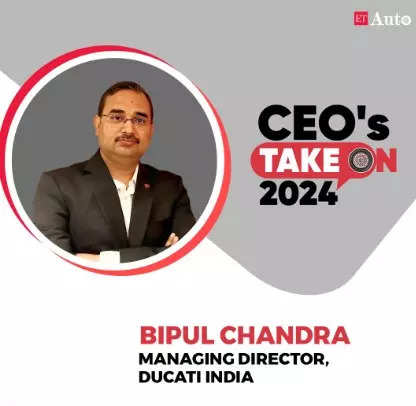
The excerpts:
Q: After two consecutive years of record-high sales performance, what is your outlook for 2024?
Continuing our tradition of innovation and excellence, Ducati India is excited to bring 8 bikes to the Indian market this year. This lineup will include some of the most exclusive and limited-edition models, showcasing our commitment to delivering unparalleled performance and luxury to our customers. Building on the momentum of our achievements in 2023, such as showing our mettle at the first-ever Indian MotoGP race at BIC and defending both the MotoGP and WSBK titles, we are proud to highlight the ingenuity and craftsmanship of our engineers at Bologna.
These accomplishments underscore our relentless pursuit of excellence and our dedication to pushing the boundaries of motorcycle engineering. As we embark on 2024, we are poised to make it another tremendous and memorable year for Ducati enthusiasts in India and around the world.
Q: What are the key micro and macro factors that will play an important role in shaping up 2024?
Consumer preferences are undergoing significant changes, increasingly favouring sustainable and environmentally conscious alternatives, which will heavily influence the types of vehicles in demand. Moreover, the broader economic landscape, including factors such as GDP growth, inflation, and interest rates, will impact consumer purchasing power and subsequently shape the automotive market. Initiatives like Make in India and the expansion of imports and exports between countries are fostering heightened competition, driving traditional automakers and tech companies to innovate and improve, ultimately leading to higher levels of customer satisfaction.
The competition, particularly in areas like electric vehicles and autonomous driving, underscores the industry’s evolution towards more innovative and user-centric approaches, with traditional automakers leveraging their manufacturing expertise while tech firms bringing disruptive technologies to reshape the future of mobility. Due to the technological advancements and the changing scenario, we will also see manufacturers in India scaling up and introducing cutting edge tech features in their product line up in terms of design, riding modes, electronics etc.
Q: How do you think the electric vehicle industry will perform in 2024?
At Ducati India, we acknowledge the growing importance of electric vehicles (EVs) in the automotive industry, including the two-wheeler segment. While we continue to focus on our core strengths in performance-oriented motorcycles, we recognize the potential of EVs in addressing sustainability concerns and evolving consumer preferences.
In 2024, we anticipate continued advancements in EV technology, infrastructure, and consumer acceptance. While Ducati remains committed to working on every future technology in the best way possible, we are closely monitoring the EV landscape and evaluating opportunities to introduce electric models in the future. We are the factory supplier for the MotoE racing series starting 2023 which means we are already learning and we have a race bike ready which will prepare us for the future.
We believe that EVs will play an increasingly significant role in the automotive market, and we are committed to exploring ways to leverage this trend while maintaining our brand’s values of style, sophistication, and performance.
Q: What will be the key technologies that will shape the next decade of the mobility industry?
In the evolving landscape of two-wheeler technology, innovations such as Augmented Reality (AR) are revolutionizing customization experiences. With virtual showrooms and design studios, riders can now visualize their desired modifications in real-time before making any alterations, enhancing their purchasing journey. Moreover, connected mobility solutions are integrating smartphone connectivity features, providing riders with seamless access to charging, music, and premium functionalities while on the move. Alongside this, premium two-wheeler brands like Ducati are already equipped with advanced radar systems enabling features like Adaptive Cruise Control, Blind Spot Detection, casting navigation on the screen offering real-time traffic updates, and the expansive use of carbon fibre to reduce weight and improve performance.
Q: Do you think the auto industry in India has the potential to become the global manufacturing hub and play an important role in the global value chain?
In the coming decade, technology advancements are poised to redefine the mobility industry in India, with the ambitious goal of positioning the country as its foremost market globally. With access to abundant materials, cutting-edge technology, and a skilled workforce, India is well-equipped to drive this transformative journey forward. The momentum is already evident in the significant growth in motorcycle production and sales volume during the fiscal year 2023 (April 2022-March 2023).
Recording a remarkable 9.2% year-on-year increase in production to reach 19.46 million units and a notable 16.9% rise in sales, totalling 15.86 million units, this marks the sector’s first uptick in three years. These robust figures underscore India’s potential as a dynamic hub for innovation and production in the global mobility landscape, setting the stage for further advancements and market leadership in the years to come.
Q: What are the key factors that work in favour of India and what limitations do we have as a country?
India possesses several advantages that position it favourably to become a global manufacturing hub. With a large and diverse market, the country offers ample opportunities for scaling up production and catering to various consumer segments.
India boasts of a skilled workforce across different sectors, providing cost-effective and efficient manpower for manufacturing operations. Its strategic geographical location facilitates easy access to global markets, enhancing supply chain management and distribution networks. Additionally, government initiatives like “Make in India” aim to promote domestic manufacturing by offering incentives, subsidies, and favourable policies to attract foreign investment.
Despite these advantages, India faces challenges such as infrastructure upgradation, skill mismatch, and knee-jerk reaction to external changes. Addressing these limitations through targeted reforms, investments, and planning will be essential for India to realize its full potential as a global manufacturing powerhouse.
Q: What is your vision for 2030 for the automotive industry?
There will be a noticeable shift towards sustainable luxury, reflecting consumers’ growing awareness and preferences for eco-friendly options. This trend aligns with broader societal concerns about environmental conservation and responsible consumption.
As access to information increases and competition intensifies, consumers will have a wider array of knowledge and options to choose from, empowering them to make more informed decisions based on their preferences and values. With rising disposable incomes, individuals will have the financial freedom to purchase vehicles tailored to their tastes and preferences, indulging in customizations to enhance their driving experience further. This convergence of sustainability, choice, and personalization reflects the changing dynamics of the automotive market, where luxury is not just about opulence but also about conscientious consumption and individual expression.

















